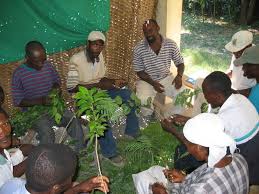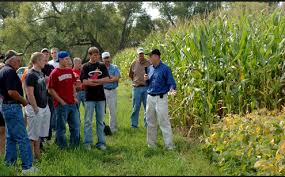In this article, various agricultural extension teaching methods are examined. Teaching involves imparting information, and in agricultural extension, teaching is a process that guides learning so that farmers acquire more knowledge and skills. Agricultural extension teaching methods are discussed under the following subheadings:
Definition and Conditions for Effective Agricultural Extension Teaching Methods
Extension teaching methods are devices used to create situations that allow information to flow freely between the extension worker and the farming communities.
The extension worker is responsible for using methods that give rural people the opportunity to learn, while stimulating mental and physical engagement. To be effective, extension workers must have technical knowledge, understand educational processes, and maintain a positive attitude toward rural communities.
Four essential conditions for effective use of extension methods include:
1. The learning situation: This includes the extension worker who has clear objectives, understands the subject matter, and communicates effectively with farmers. It also includes learners who are capable and interested, and relevant subject matter that is appropriate to their level. The physical setting must be distraction-free, suited to the subject, readily available, and skilfully used.
2. Clearly defined objectives: These must be well established before applying any method. An objective is the goal toward which teaching is directed and must include four elements: the audience, the behavioural change, the subject matter, and the context in which it applies.
3. Use of effective learning experiences: A learning experience is the mental or physical reaction in a learning situation, whether through seeing, hearing, or doing.
4. Use of a variety of methods: A range of extension methods must be employed to ensure effectiveness.
Read Also: Poultry Farming and Adverse Season as a Stressor
Individual Methods of Agricultural Extension Teaching

Individual methods recognise that learning is personal, and the extension worker’s influence is key to participation in extension activities. The individual methods include:
a. Farm and home visits:Allow for private discussions between the extension worker and farm families. They help:
- Acquaint the extension worker with the farmer and family
- Address specific requests
- Gain firsthand knowledge of farm problems
- Explain recommended practices
- Follow up on previous advice
- Plan or invite farmers to activities
- Discuss agricultural policies
- Recruit or encourage local volunteer leaders
Preparation is essential, including reviewing farm details and preparing necessary materials.
b. Office calls: Farmers initiate these visits to seek help with specific needs. These visits help the extension worker understand community needs and build public trust. While less time-consuming and costly than visits, they may limit open discussion.
c. Telephone calls: These are used to provide information on disease treatment, pest control, or follow up on broadcast content. However, they rely on functioning communication infrastructure.
d. Personal letters: Used to respond to information requests, follow up visits, or reach local leaders. Their effectiveness is limited where postal systems are poor or literacy levels are low. Letters must be clear, concise, and complete.
e. Informal contacts: Occur during events like market days or festivals. These casual interactions can lead to valuable exchanges of information and allow the extension worker to better understand rural challenges and provide informal advice.
f. Result demonstration: A teaching method that shows the practical value of a recommended practice. For example, comparing two fields one with compost and good seeds, and one without demonstrates improved yield from better practices.
Advantages include:
- Provides local proof of success
- Useful for introducing new topics
- Visually convincing
- Generates media content
- Supplies cost data
- Easily understood
- Promotes local leadership
- Builds trust in extension work
Limitations include:
- Time-consuming
- High cost per change
- Limited availability of good demonstrations
- Few observers at early stages
- Results affected by weather
Read Also: Steps to Combat Heat Stress in Poultry Birds
Group Methods of Agricultural Extension Teaching

Group methods consider how individuals are influenced by their social groups and value the opinions of others before making agricultural decisions. Methods include:
a. General meetings: Used for purposes other than demonstrations, involving lectures, discussions, films, or a combination. Visual aids should be included. Time must be allocated for questions and answers. Successful meetings require the help of local leaders to:
- Agree on meeting purpose and draft a programme
- Choose and invite speakers
- Arrange recreational activities
- Set time and place
- Select a chairman and promote the meeting
Types of meetings as identified by Kelsey and Hearne (1966):
1. Organisation meetings: For boards, youth clubs, committees, etc.
2. Planning meetings: Require detailed situation analysis and careful facilitation.
3. Training meetings: Help in the development of rural leaders.
4. Special interest meetings: Focused on specific areas like gardening or dairying.
5. Community meetings: Open to all community members regardless of age or interest.
Advantages of meetings:
- Reach a large audience
- Prepare for other extension methods
- Use group dynamics to promote programs
Limitations of meetings:
- Limited discussion time
- Difficulties handling diverse audiences
Group Discussion as an Extension Method

Types of Group Discussions
Group discussion is a common method used in extension work. It involves two or more individuals pooling their knowledge and opinions to clarify specific issues through mutual agreement.
1. Brain Trust: This is a modern type of group discussion where participants respond to posed questions by sharing their ideas. It closely resembles a panel or symposium.
2. Panel Discussion: A panel is usually informal and involves a group of experts discussing a major topic. It allows for spontaneous contributions without prepared speeches.
3. Symposium: In a symposium, each speaker presents a detailed and usually prepared speech. There is often an opportunity for rebuttals or comments from other speakers.
Exhibits in Extension Work
Exhibits are organized displays of specimens, models, posters, or charts. Their purpose is to spark interest, change attitudes, increase knowledge, and inspire action. They are particularly effective in educating illiterate populations.
An exhibit may be small, such as a display of maize plants under different fertilizer treatments, or large, such as a national agricultural fair. For extension purposes, exhibits should remain simple and focus on conveying one idea at a time.
Tours and Field Trips
Tours and field trips fulfill the human desire to explore and observe. They involve taking a group of people to observe practical applications of improved farming practices. This method provides real-life learning and is particularly suitable for groups like Young Farmers Clubs.
Guidelines for Planning a Successful Tour
1. Decide the specific objective of the tour
2. Plan the tour in detail well ahead of time
3. Conduct a rehearsal of the entire program
4. Keep the group together and moving efficiently on the day of the tour
5. Smaller groups are more effective than large groups
Method Demonstration
A method demonstration is used to teach a specific skill. It shows how to do something and is very engaging for farmers, especially when carried out effectively by the extension worker.
Examples include:
(i) seed treatment
(ii) pruning
(iii) spraying
Key Points to Observe in Method Demonstration
- Outline steps logically
- Identify the key operations
- Select appropriate materials and tools
- Use diagrams or teaching aids
- Rehearse for accuracy
- Ensure visibility and audibility
- Explain relevance to local problems
- Demonstrate slowly and clearly
- Emphasize the key steps
- Allow audience participation
Advantages of Method Demonstration
1. It teaches useful skills to many people simultaneously
2. Seeing, hearing, discussing, and doing stimulate action
3. Builds confidence in the extension worker
4. Simple demonstrations can be repeated by local leaders
5. Encourages interaction between the demonstrator and the audience
6. Promotes practice change in large groups
Limitations
1. Not all participants may see clearly
2. Equipment may be difficult to transport
3. Requires presentation skills that not all workers may have
Extension Schools
Extension schools aim to deliver in-depth knowledge and skills in specific subjects like irrigation, dressmaking, or gardening. Training may last from one to four days and often requires prior registration and full attendance.
These schools are effective for sharing a large volume of information in a short time. Success depends on clear objectives, engaging teaching methods, and regular evaluations.
Farmer Training Centres
Farmer training centres play a vital role in improving the knowledge and leadership skills of farmers and their families. To be effective, these centres must align their training with the goals of extension programmes.
Requirements for Effective Farmer Training Centres
1. Training content must align with the objectives of extension programmes
2. Participants should be selected based on leadership potential
3. Trained participants should assist in executing extension activities
Mass Methods of Extension Communication
Individual and group methods have limited reach. Mass methods such as radio, television, cinema vans, public address systems, newspapers, posters, and printed materials can spread agricultural information widely and quickly.
a. Radio
Radio is powerful and often the only communication method available in rural areas. It reaches people regardless of literacy, and is ideal for announcements, insect outbreak warnings, or campaign messages. Recording allows flexibility in location and timing.
b. Television
Television adds a visual aspect to radio, allowing demonstrations. It requires thorough preparation and is growing in importance despite the cost of equipment.
Advantages of Radio and Television
1. Suitable for emergency messages
2. Reaches illiterate individuals
3. Reaches those who cannot attend meetings
4. Builds interest in other extension activities
Limitations
1. Not all areas have broadcast facilities
2. Audience cannot actively participate
3. Farm-related content may not get favorable airtime
4. No direct audience feedback
5. Entertainment may overshadow educational content
6. Cultural or language barriers may exist between speaker and listener
c. Cinema Vans and Public Address Systems
In countries where television access is limited, cinema vans show agricultural films in villages. These films demonstrate practical techniques. Public address systems are used for announcements and spreading messages quickly across villages.
d. Newspapers
Newspapers are useful where available and accessible to rural readers. They must be written simply, accurately, and clearly to stand out. Headlines should be attention-grabbing, and the most important facts should appear first.
e. Posters
A poster is a visual tool with minimal words and a strong central message. It is designed to quickly catch attention and inspire action.
Tips for Designing Posters
- Know the target audience and desired action
- Use simple words and strong visuals
- Create a catchy slogan
- Use bold lettering and limited color for clarity
- Leave enough space and avoid clutter
f. Folders, Leaflets, and Pamphlets
These materials are cost-effective and useful for specific messages, reminders, or supplementing larger publications. They can be distributed at events or advertised during radio programmes.
Do you have any questions, suggestions, or contributions? If so, please feel free to use the comment box below to share your thoughts. We also encourage you to kindly share this information with others who might benefit from it. Since we can’t reach everyone at once, we truly appreciate your help in spreading the word. Thank you so much for your support and for sharing!

